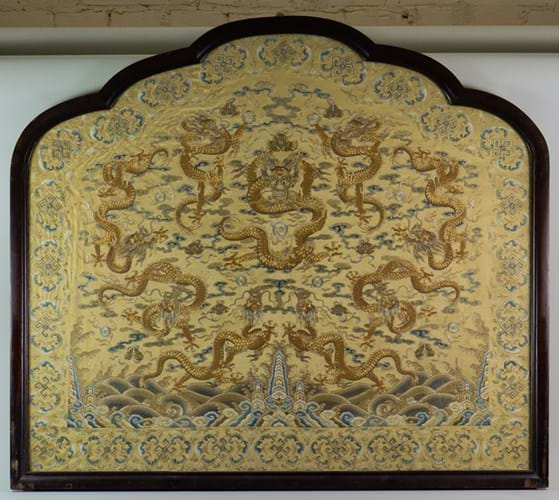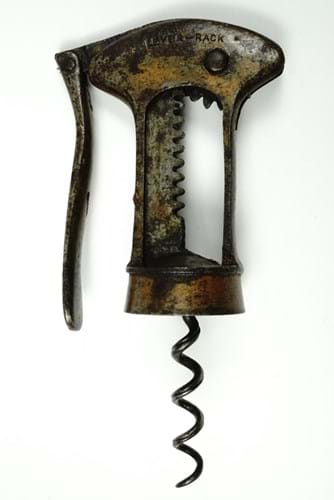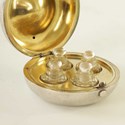1. Moule patent earth closet – £320
During the Victorian era, the Rev Henry Moule (1801-80) of Fordington was doubtless considered something of a zealot. Running his vicarage like a commune, complete with vegetable garden and livestock, in 1859 he invented the first composting toilet.
Moule (pronounced Mole) was conscious of the need to prevent the spread of disease, but he also disapproved of the water closet on theological grounds as he felt it polluted God’s rivers and seas and was a waste of nutrients which should be returned to the soil. More than a century ahead of his time, he published several works on this subject the first being Advantages of the Dry Earth Sytem in 1868 and he set up the 'Moule Patent Earth Closet Co. Ltd' which manufactured and sold earth closets.
A sale of Rural and Domestic Bygones at Clarke & Simpson in Framlington, Suffolk, on February 5 featured one of his later patents, this 1873 version with its mahogany box and cast iron frame. Dry earth or peat is put into the hopper at the back of the seat and deposited via a lever into a bucket placed below. Estimated at £100-200, it took £320.
Moue’s ideas did prove influential. In India in particular the system was used in many public buildings while in 1868 the Lancet reported that 148 of his dry earth closets were used by 2000 men at an army volunteer camp in Wimbledon encampment “without the slightest annoyance to sight or smell”.
2. Qing embroidered cushion cover – £26,000
Qing period embroidered satin throne-back cushion covers can be seen still in situ in a number of the buildings of the Forbidden City in Beijing including the Hall of Supreme Principle and the Palace of Eternal Spring.
Others are held by institutions and collectors throughout the world. This example, dated to the 18th century, was offered for sale at the Canterbury Auction Galleries on February 5 where, estimated at £3000-5000, it took £26,000.
The design in coloured silk and gold threads to the imperial yellow ground (now uniformly faded) includes nine dragons and clouds above the terrestrial diagram emerging from rolling waves. In a later mahogany frame measuring 2ft 8in x 3ft 1in (82 x 94cm), it was in decent condition save the loss of some of the gold threadwork.
The price was akin to that realised by other throne covers in recent years – the exception being the massive £193,000 bid at Christie’s London in 2011 for a cover centred by a single large dragon clutching a shou character above his head. Dated c.1800, it was described by Christie’s as among the finest examples known.
3. Hipkins patent corkscrew c.1879 – £1650
The task of removing a cork from a bottle with minimum effort and distress was one that vexed many Victorian inventors and spawned numerous different patent designs based on simple mechanics.
The model pictured here, offered for sale at Laidlaw in Carlisle on February 5 with a guide of just £30-40 but sold at £1650, is marked No. 3167, and Patent GF Hipkins & Son Lever-Rack.
George Frederick Hipkins of Birmingham was the maker of steel eyebrow corkscrews and a number of other Victorian ‘mechanical’ corkscrews including the Lund’s and the Hiram Codd patents but this model was patented by his son William Edward Hipkins in 1879.
Composed of a framed rack with a central hinge, the cork is removed by a single concave lever.
The estimate was certainly modest for a corkscrew that has long been recognised among the most desirable Victorian patents. The Hipkins is mentioned in both Mechanical Corkscrews: Their Evolution, Actions, And Patents (1999) by Ferd Peters and British Corkscrew Patents from 1795 (1997) by Fletcher Wallis while other examples have sold at auction for £1500-3000 in the past decade.
4. Silver half crown token – £3000
The third and final part of the collection of 19th century silver trade tokens formed by John Akins was offered by Dix Noonan Webb as part of its February 1-2 sale. Comprising 115 lots, the highest price was achieved by a rare half crown token dating from 1811 showing a view of Staverton Mill in Wiltshire.
Guided at £2000-3000, it was bought by a collector in the US at the top estimate.
Silver tokens of such relatively high value are typically much scarcer than the copper tokens that were widely issued as halfpennies, farthings or pennies to fulfil a need for small change. Typically, the minting of tokens of larger denominations was frowned upon by the authorities and only tolerated at times of a wider shortage of silver coins.
This particular token, one of the classic tokens in the entire series, was issued in 1811 by John Jones, the proprietor of the Staverton Super-fine Woollen Manufactory. The mill sited on the Avon was said to house 40 looms and the very latest in textile technology.
When in 1808 hostilities between the industrialist and local wool shearmen who feared for their livelihoods reached a peak, Jones was attacked and shot in the face. His offer of a £500 reward for the capture of the culprits was never claimed. Ultimately the year after this coin (and a similar copper penny) was issued, Jones was declared bankrupt in November 1812 and he died within weeks. The mill as depicted on the token, engraved by Thomas Wyon, later burnt down in 1824. Another building was erected on the site the following year and was acquired in 1897 by the Anglo-Swiss Condensing Milk Co, better known today as Nestlé.
It is thought to be only the third example of this token offered at auction in the past 30 years, others selling for £1950 (May 1999) and £1600 (March 2003).
5. Victorian perfume box by Henry William Dee – £2400
The sale at Hutchinson Scott in Skipton, North Yorkshire on February 4 included this Victorian perfume box by Henry William Dee, London, 1877. Estimated at £1500-2500, it made £2400.
Modelled as a curled-up otter with cabochon garnet eyes, it opens to reveal a fitted gilt interior with four glass perfume bottles. The inner rim is engraved for the retailer Jones, Bt. des Capucines, Paris. 41 St. James’s St. London. It was purchased by the vendor from Gerald Sattin Antiques.
Henry William Dee made a speciality of silver novelties made for Garrard, Leuchars & Son and Asprey’s and other retail goldsmiths. The patterns for many were registered as copyright. This particular box assumes the form of an animal that until the late 19th century was a source of natural musk, used in the perfume industry as a fixative to reduce the rate of evaporation.













